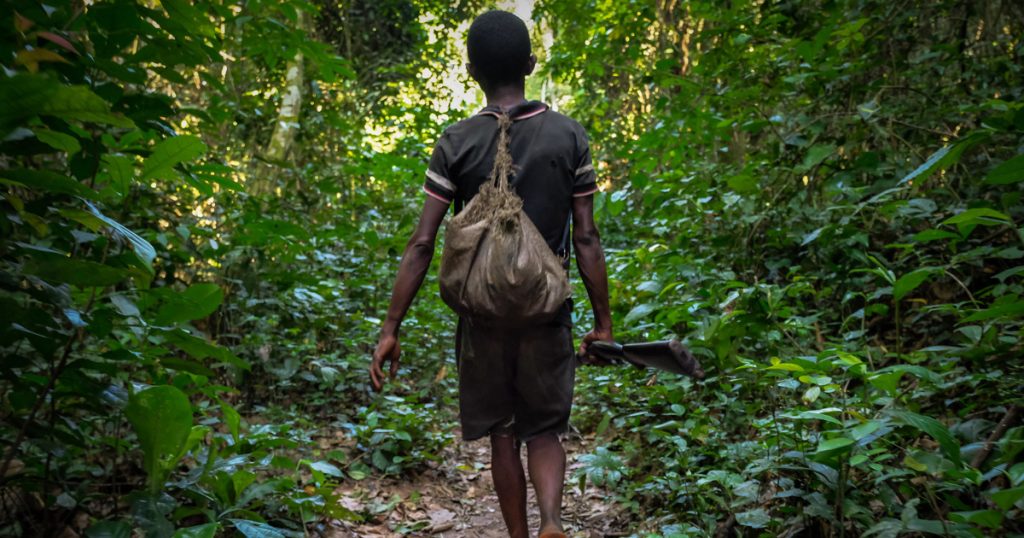
NAIROBI, Kenya (7 January 2025) – Advances in data availability and accessibility have resulted in a groundbreaking new study on wild animal hunting in African tropical forests.
“This paper’s findings reveal concerning trends towards increased commercial hunting and associated depletion of large-bodied wildlife,” said Lauren Coad, a co-author and scientist at CIFOR-ICRAF. “Sustainable wildlife management solutions, coupled with continued long-term monitoring, are urgently needed to preserve Central Africa’s wildlife resources.”
The study, published in Nature Sustainability by lead authors Daniel Ingram (Durrell Institute of Conservation and Ecology, University of Kent), Katharine Abernethy (University of Stirling), Jörn Scharlemann (formerly University of Sussex), and CIFOR-ICRAF’s Coad, is the first to explore the factors that influence wild animal hunting patterns across African tropical forests — in detail, and on a regional scale.
Conducted in collaboration with many organizations including the Wildlife Conservation Society (WCS) and the Institut de Recherche en Ecologie Tropicale (IRET), the research made extensive use of wildmeat.org — the largest compilation of African hunting data to date — to explore the socio-cultural, economic, and landscape variables associated with wild animal hunting across 115 settlements in African tropical forests. Through a synthesis of 83 studies published between 1991-2020, researchers found evidence that:
- Village hunters increasingly use guns instead of traditional tools (for example spears) and traps, which makes it easier to target commercially viable species. Such an increase may have a more significant negative impact on primate populations, given their high market value.
- There has been a shift from subsistence hunting to commercial hunting of wild animals, which provides meat for growing urban populations. This shift is also associated with an increase in the amount of wild animal meat taken out of the landscape per hunter per day, known as hunting “offtakes”.
- Hunters who took the most wildlife:
- sold a greater proportion of their catch compared to traditional hunter-gatherers who typically harvest wild meat for personal or community consumption.
- were those with better access to healthy forests, protected areas and more remote locations that tend to have larger animal populations.
- There has been an expansion in wild meat trade since 1991, with a potential decline in larger wildlife in easily accessible areas with degraded forests.
“Our study highlights how important it is for countries to develop robust monitoring and management frameworks for hunters and traders,” said lead author Ingram. “Without monitoring hunted species populations and the numbers of animals hunted, the sustainability of hunting systems remains unknown.”
Comparative research studies — that are made possible through access to large, topic-curated databases — serve as a vital resource for decision-makers, conservationists, and studies. Through improved, big-picture clarity, these stakeholders are better equipped to design and implement strategies that conserve key ecosystems.
For more information, please contact Daniella Silva at d.silva@cifor-icraf.org.
About CIFOR-ICRAF
The Center for International Forestry Research and World Agroforestry (CIFOR-ICRAF) harnesses the power of trees, forests and agroforestry landscapes to address the most pressing global challenges of our time – biodiversity loss, climate change, food security, livelihoods and inequity. CIFOR-ICRAF is a non-profit science institution that generates and applies evidence to meet today’s most pressing challenges, including energy insecurity and the climate and biodiversity crises. Over nearly 50 years, we have built vast knowledge on forests and trees outside of forests in agricultural landscapes (agroforestry). Using a multidisciplinary approach, we seek to improve lives and to protect and restore ecosystems. Our work focuses on innovative research, partnering for impact, and engaging with stakeholders on policies and practices to benefit people and the planet. Founded in 1993 and 1978, CIFOR and ICRAF are members of CGIAR, a global research partnership for a food-secure future dedicated to reducing poverty, enhancing food and nutrition security, and improving natural resources.













